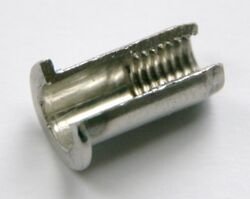Engineering:Rivet nut
A rivet nut, also known as a blind rivet nut, or rivnut,[1] is a one-piece internally threaded and counterbored tubular rivet that can be anchored entirely from one side. It is a kind of threaded insert. There are two types: one is designed to form a bulge on the back side of the panel as a screw is tightened in its threads. The other is similarly drawn in using a screw, but is drawn into the sleeve instead of creating a bulge.[2][3]
History
The first rivet nut was created by BF Goodrich in the 1930s, and sold under the trademark RIVNUT®. It was first used to mount rubber de-icing boots to aircraft wings.[4]
Usage
In the field of aviation, rivet nuts are often used to attach various items, such as static dischargers and inspection access covers, to the surface of an aircraft.[citation needed] Rivet nuts are an ideal replacement for weld nuts because they will not distort base materials, eliminate weld splatter, toxic fumes, and other by-products of the welding process, and can be installed in many different kinds of material including steel, plastic, composites, and fiberglass. [5]
See also
References
Notes
- ↑ Smith, p. 112.
- ↑ McMaster-Carr, p. 3213.
- ↑ McMaster-Carr, p. 3215.
- ↑ Smith, pp. 111–112.
- ↑ "Blind Rivet Nuts". https://fasteners.sherex.com/category/blind-rivet-nuts. Retrieved 2 July 2018.
Bibliography
- RIVNUT® The Original Blind Rivet Nut, Böllhoff Inc., 2010, https://media.boellhoff.com/files/pdf12/rivnut-us-version-en.pdf, retrieved 2018-09-25
- McMaster-Carr catalog (114th ed.), McMaster-Carr.
- Smith, Carroll (1990), Carroll Smith's Nuts, Bolts, Fasteners, and Plumbing Handbook, MotorBooks/MBI Publishing Company, ISBN 0-87938-406-9, https://books.google.com/books?id=A81HmmRCN7YC.
 |




